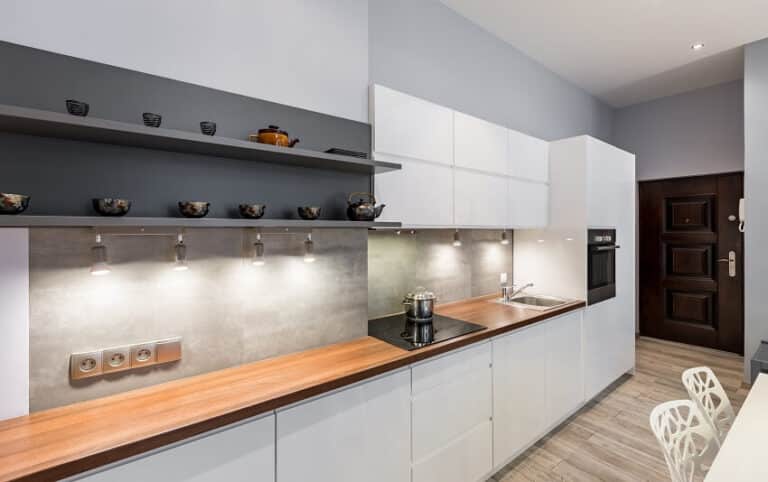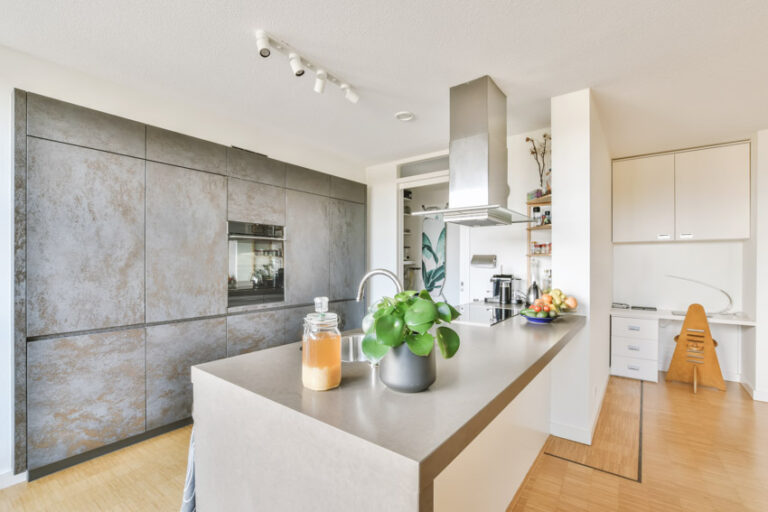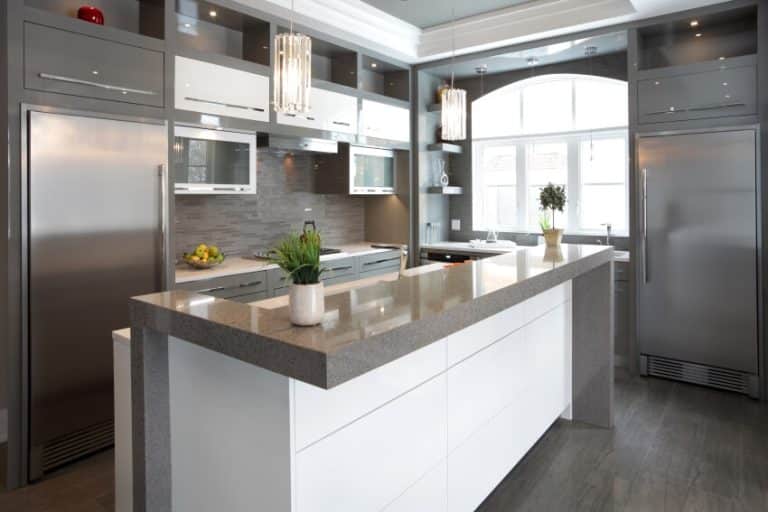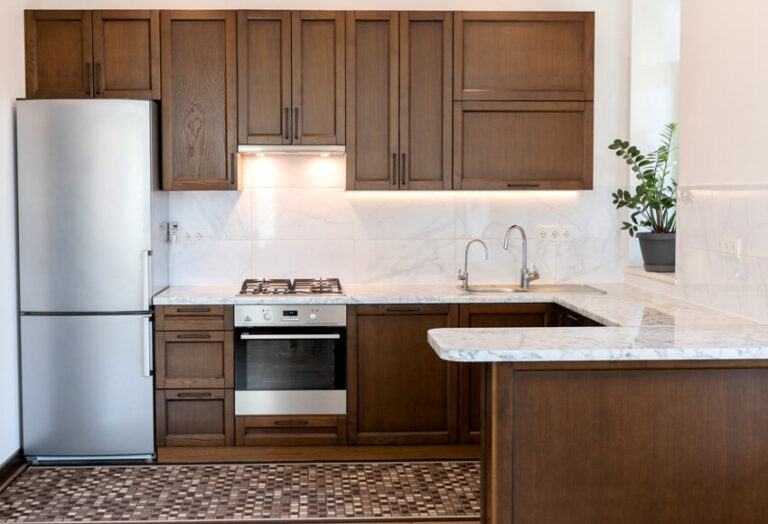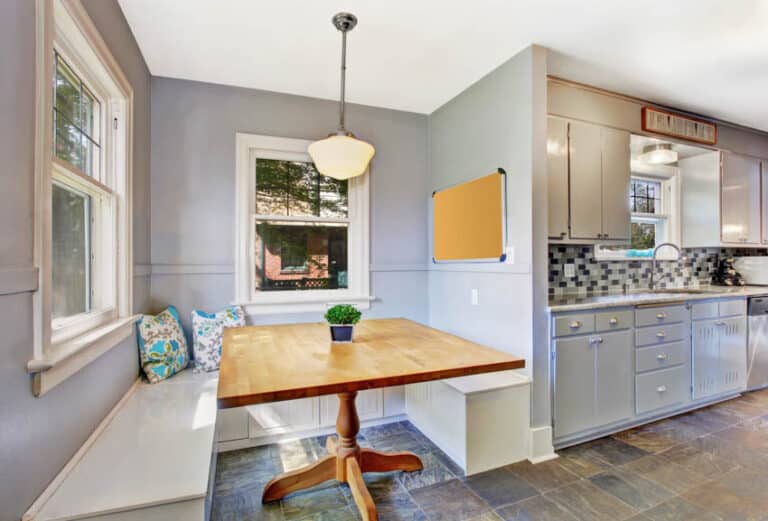How To Design A Tuscan Kitchen: Designer Ideas
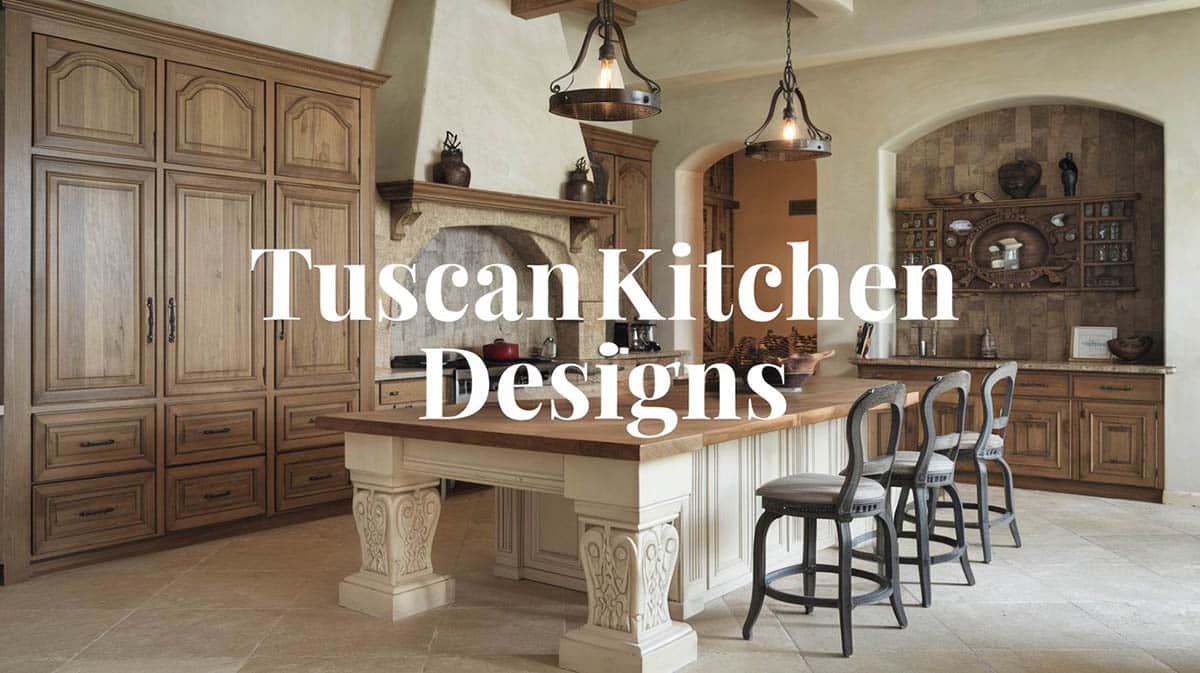
This guide showcases elegant Tuscan kitchen ideas, including a variety of cabinet styles, flooring, islands, and decor. A Tuscan-style kitchen brings rich, warm tones, Italian architecture, and rustic cabinetry together to create a gorgeous space for cooking and dining. Many million dollar homes are equipped with luxury Tuscan kitchens to increase the value and appeal of their home.
Tuscan Kitchen Designs
For people who enjoy the luxurious appeal of Italian kitchens, yet prefer a more relaxed, casual feel, Tuscany is a great style option. As its color scheme leans towards warm, earthy tones, it has a more welcoming ambiance, and the finishes used on Tuscan kitchens also give a more homey feel, as it looks more like a well-used kitchen rather than a showroom/showcase space for display.
This style is perfect for those who love Italian kitchens’ detail and classic appeal, yet prefer a more laid-back country villa feel. To achieve this style, one must take note of the following important features typical of Tuscan kitchens.
Colors – This style typically uses warm colors reminiscent of the colors found naturally in Tuscany, such as orange, ochre or terracotta. Layer those main hues with dusty sage green, muted indigo, or soft buttercream as secondary accents. A painted island in a desaturated Tuscan red can become a focal point without overwhelming the palette. When selecting wall paint, look for finishes with a subtle chalky or lime‑wash texture to avoid an overly crisp, modern surface.
Cabinetry – Matte, rustic finishes are typically preferred to give that worn-out/well-used look, and can either be painted or kept in their natural color. You will also notice the use of open displays or glass-door cabinets, which allow you to showcase Italian ceramics and other precious items. There is also a tendency to mismatch cabinetry, making them look like movable furniture pieces.
Opt for inset doors with simple chamfered edges or an antiqued bead detail. Hand‑forged iron pulls—preferably with a time‑worn patina—reinforce authenticity. Integrate a freestanding hutch or plate rack in a contrasting finish to mimic the “collected over time” aesthetic. For painted cabinets, ask your finisher to rub back edges lightly and add a subtle umber glaze in grooved profiles.
Countertops – For countertops, matte natural stones are still preferred over glossy materials, but the backsplash would sometimes have a few glossy tiles or stones for a little more contrast. Honed travertine, soapstone, or leathered granite pair well with this style because their subdued sheen hides daily wear. A small section of hand‑painted Majolica tiles behind the range can introduce storybook color without dominating the room. When budget allows, frame the cooking niche in a mitered edge of reclaimed pietra serena (gray sandstone common in Tuscan architecture).
Keep countertops partially cleared so each curated accent—like a vintage mortar and pestle or an artisan olive‑oil bottle—feels intentional rather than cluttered. Introduce greenery with small potted rosemary or basil for authenticity and aroma. Finally, finish the space with textured linens, a woven rush seat on counter stools, and aged‑bronze switch plates to harmonize every detail.
Flooring – Flooring material also naturally uses a warmer color palette. Some of the common materials used are terracotta tiles, marble, ceramic tiles, mosaic tiles, hand-painted tiles for accent, and sometimes, hardwood is used as well. Consider laying terracotta in a traditional herringbone or diagonal pattern, bordering the field with a soldier course of hand‑painted inserts every few feet for gentle visual rhythm. If using hardwood, specify wide planks (6″‑8″), lightly wire‑brushed and finished with a matte hard‑wax oil in a medium chestnut tone to evoke old farmhouse floors.
Motifs – vines, grapes, olives, lemons, urn with flowers are just some of the common motifs you will find in a Tuscan style, typically applied as cabinetry carvings, stenciled on cabinet doors or table tops, hand-painted on ceramic tiles or inlaid on stone/tiles. Introduce subtle relief corbels featuring acanthus leaves beneath island overhangs. A forged‑iron pot rack with scrolling vine ends adds both motif and function above a butcher‑block prep table. For soft goods, choose linen runners or café curtains embroidered with small olive sprigs rather than large printed patterns to keep the look refined.
Lighting – Tuscan-style spaces are also abundant in natural lighting and are often a place for gathering and a center of family activities, and therefore have a sense of openness to it, allowing conversation and dining in the kitchen. You will also notice that Tuscan-style spaces have an area dedicated to baking, which may or may not look different from the rest of the space.
Install wrought‑iron chandeliers or lanterns fitted with warm “candle” bulbs (2700 K). Undercabinet lighting can be hidden behind a small molding strip stained to match the doors, preventing modern strips from breaking the period feel. Over the baking area, a hanging copper pendant or simple ceramic shade provides task light while reinforcing the room’s hand‑crafted narrative.
Walls – Consider rough‑plastered walls or a lightly troweled Venetian‑plaster finish to deepen the sense of age. Open ceiling beams—left natural or lime‑washed—instantly ground the room in rustic authenticity. If the architecture allows, add a small arched niche near the range to display olive‑oil decanters or family heirloom cookware.
As with any design style, balance is key to creating a good design. For Tuscan kitchens, dark/natural wood cabinets are usually paired with lighter wall finishes, while cabinets painted white are usually paired with warm wall colors for contrast. Accessorizing is also an important aspect of Tuscan kitchens, as you would often have glass jars with pickles or preserves, or decorative ceramics on display.
Below are some excellent ideas you can use to bring this beautiful style to your home:
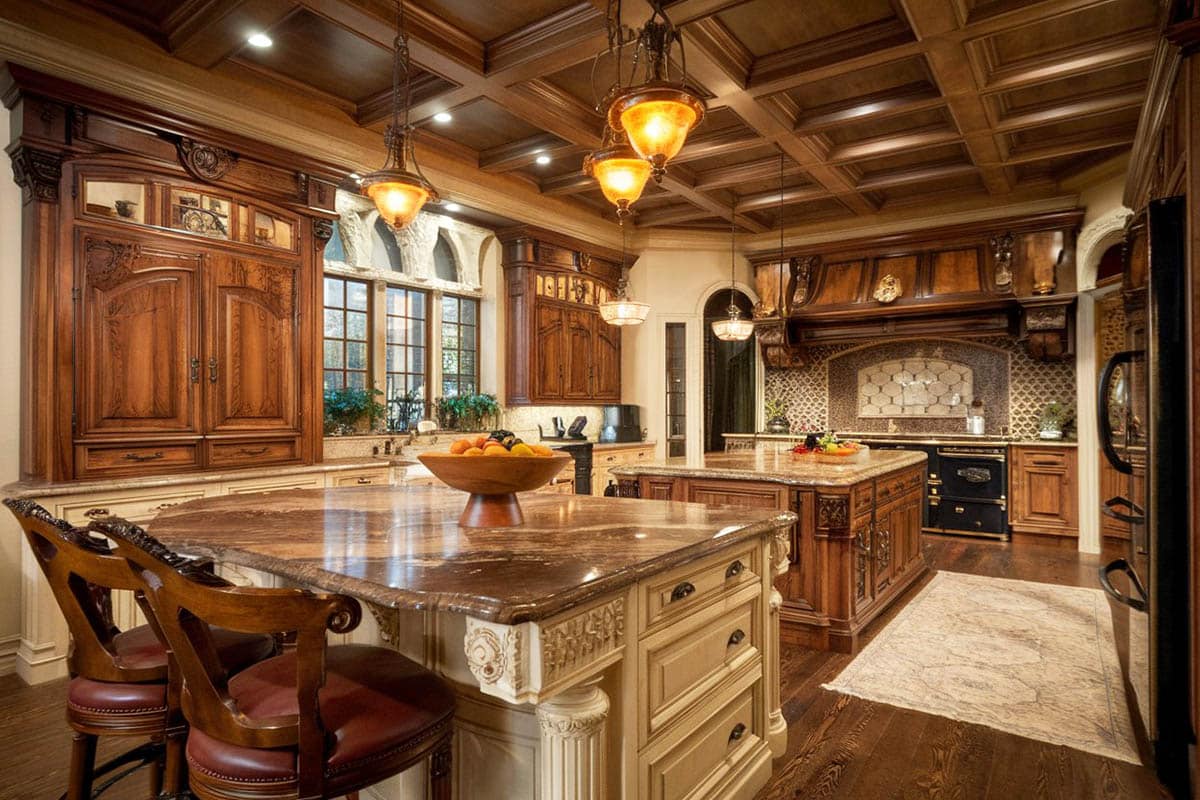
The beautiful Tuscan kitchen shown in the picture above is both spacious and luxurious. Its detailed coffer ceiling already sets the classic/traditional vibe of this kitchen as it boasts of moldings and details typical of classic interiors. Rustic mahogany floors and off-white walls set a warm background to the space, allowing the cabinets’ weathered wenge finish to stand out. In this design, storage space is given priority, especially on the wall cabinets and counters.
Much of the space is dedicated to cabinet storage and displays, while counter space remains mainly on the large kitchen island. The matte wengue finish has a weathered look and has classic Italian motifs like turned spindles, decorative corbels with acanthus leaf carvings, and wooden panels with stenciled flower paintings. This kitchen also has a separate island counter, which is higher than the standard counter height. It uses a countertop made from the solid Mahogany frame with ceramic tiles in its center. The bae cabinet is white instead of wengue, making it look like a separate piece from the rest of the kitchen.

This is a good example of a modern adaptation of a Tuscan-style kitchen. It boasts details such as dark oak wood flooring and matching oak wood exposed ceiling trusses to give that classic antique feel, while the cabinets are made of solid walnut with a strong red undertone. This modern version uses a glossy white marble countertop instead of a matte finish, which is more typical of classic Tuscan designs. Still, the use of cast iron chandeliers and hand-painted mosaic tiles for its backsplash makes up for the glossy finish of the counters.
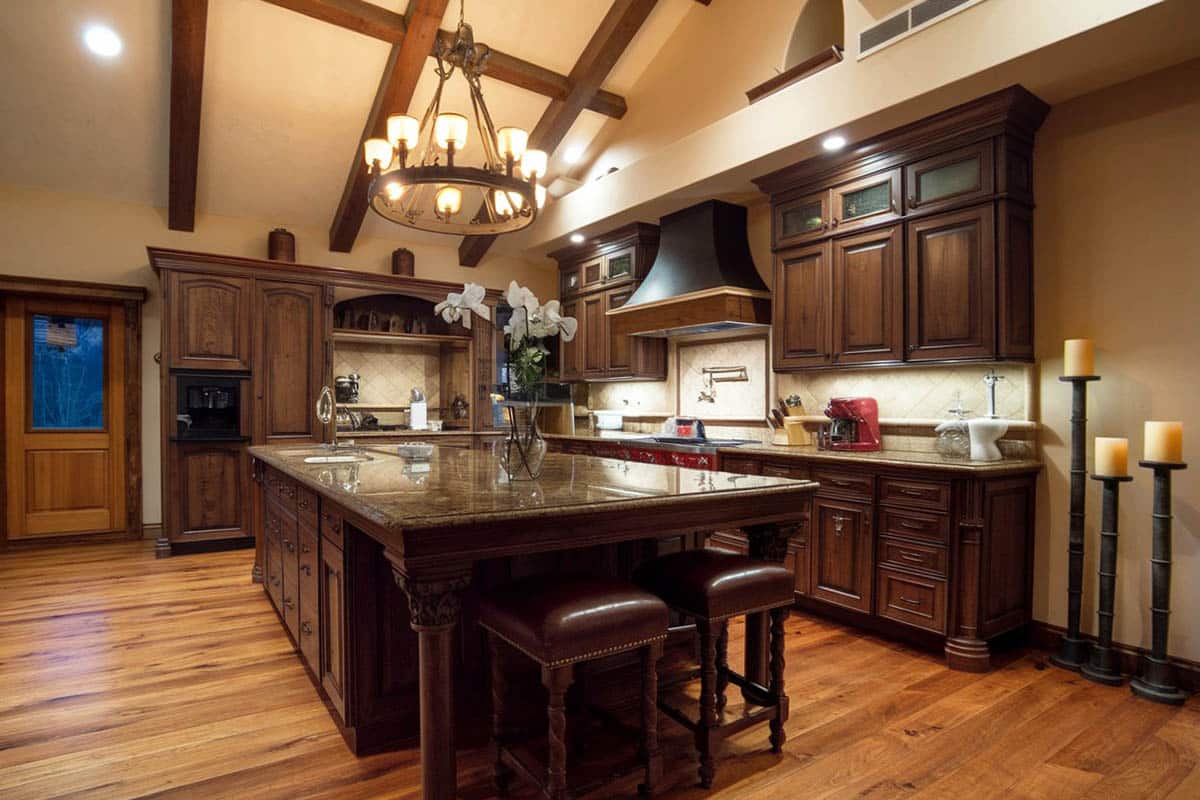
This is another excellent modern adaptation of Tuscan style kitchen design, which features rustic maple flooring, exposed mahogany ceiling trusses, beige-painted walls and solid walnut cabinetry. It uses matte granite stone for its countertop and mosaic ceramic tiles of the backsplash, adding a few hand-painted pieces at the rim of the range hood cover. The look is completed by adding cast-iron bar stools , a chandelier, and glass jars with preserved fruits as accessories. Using built-in or integrated appliances with cabinet fronts keeps true to the Italian style ambiance. Using vintage or retro appliances is another way to achieve the old-world charm look.
Marble counters are a rarity in the kitchen because of their expense. If you’re fortunate enough to own marble counters, wall tiles, or flooring, take steps to avoid stains that could mar the exceptionally luxurious appearance. – Kitchen Ideas You Can Use, Updated Edition, Chris Peterson
Related Kitchen Design Galleries You May Like:
Country Kitchen Designs – Craftsman Kitchens – Rustic Kitchen Designs – Kitchens with Dark Cabinets – Mediterranean Kitchens

